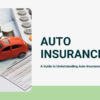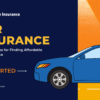Auto insurance is not just a legal requirement but also a vital aspect of safeguarding your vehicle, finances, and peace of mind. Whether you’re driving a brand-new car, a pre-owned vehicle, or even a classic collector’s item, understanding the essentials of auto insurance is crucial for all drivers. Here’s a breakdown of the key components to help you make informed decisions about protecting your ride.
1. Why Auto Insurance Matters
Accidents, theft, natural disasters, and other unexpected events can happen at any time, potentially causing significant financial loss. Auto insurance provides a safety net by covering various types of damages, liability, and other risks associated with vehicle ownership. In many places, having adequate insurance coverage is legally required to drive on public roads.
2. Types of Auto Insurance Coverage
Auto insurance policies typically consist of several types of coverage, each addressing specific risks. Understanding the different options will help you select the best coverage for your needs.
a. Liability Insurance
Liability insurance is mandatory in most states. It covers the costs if you’re at fault in an accident and cause damage to someone else’s property or injury to another person. There are two main components:
- Bodily Injury Liability: Covers medical expenses, lost wages, and other costs if you injure someone in an accident.
- Property Damage Liability: Covers the repair or replacement costs if you damage someone else’s property, such as their vehicle or a fence.
b. Collision Insurance
This coverage helps pay for repairs to your own vehicle after a collision, regardless of who is at fault. If your car is damaged in a crash, collision insurance can cover the costs of fixing it.
c. Comprehensive Insurance
Comprehensive insurance, also called “other than collision” coverage, protects your vehicle from non-collision incidents, such as theft, vandalism, fire, natural disasters, or hitting an animal. It’s not required by law, but it’s highly recommended for anyone with a new or high-value car.
d. Uninsured/Underinsured Motorist Coverage
This protects you if you’re involved in an accident with a driver who doesn’t have enough insurance (or no insurance at all). It helps cover medical expenses, car repairs, and other costs when the at-fault driver is not adequately covered.
e. Personal Injury Protection (PIP)
PIP is available in some states and covers medical expenses for you and your passengers, regardless of who is at fault in the accident. It can also cover lost wages, rehabilitation costs, and even funeral expenses in severe cases.
f. Medical Payments Coverage
Medical payments coverage, often abbreviated as MedPay, is similar to PIP but generally more limited. It covers medical costs for you and your passengers after an accident, irrespective of who is at fault.
3. Factors Affecting Your Auto Insurance Premiums
Auto insurance premiums can vary widely based on several factors. Here are some key considerations that may impact your rates:
- Driving History: Drivers with a history of accidents or traffic violations may pay higher premiums, as they are deemed higher-risk by insurers.
- Vehicle Type: The make, model, and age of your vehicle influence your premium. Luxury cars, sports cars, and vehicles with high repair costs typically cost more to insure.
- Location: Where you live plays a role in your insurance rates. Urban areas with higher traffic density and crime rates tend to have higher premiums compared to rural areas.
- Age and Gender: Young drivers, particularly males, often face higher rates due to statistically higher accident risk. Older drivers may see a decrease in premiums as they’re considered more experienced and less risky.
- Credit Score: In many states, insurers use credit scores as an indicator of financial responsibility. A lower score may result in higher premiums.
- Deductible Amount: The deductible is the amount you pay out-of-pocket before your insurance kicks in. Choosing a higher deductible can lower your monthly premium but means you’ll pay more in the event of a claim.
4. How to Save on Auto Insurance
While auto insurance premiums can be costly, there are several strategies you can use to lower your rates:
- Bundle Policies: Many insurers offer discounts if you bundle auto insurance with other types of coverage, such as home or renters insurance.
- Shop Around: Different insurers offer different rates, so it’s a good idea to compare quotes from multiple companies to find the best deal.
- Maintain a Clean Driving Record: Avoiding accidents and traffic violations can help lower your premiums over time.
- Take Advantage of Discounts: Many insurers offer discounts for things like vehicle safety features, good grades for students, and low mileage.
- Consider Usage-Based Insurance: Some insurance companies offer telematics programs where your premium is based on how often and safely you drive. If you’re a safe driver, this can lead to significant savings.
5. Understanding Your Policy and Coverage Limits
It’s essential to read your policy carefully and understand the limits and exclusions of your coverage. Pay attention to:
- Coverage Limits: This is the maximum amount your insurer will pay for claims. Ensure that your coverage limits are sufficient to cover the potential costs of an accident.
- Exclusions: Make sure you’re aware of any situations that aren’t covered by your policy, such as damage caused by certain natural disasters or accidents that occur while driving under the influence of alcohol.
6. When to Review and Update Your Coverage
Your auto insurance needs can change over time, so it’s essential to review and adjust your policy regularly. Consider updating your coverage when:
- You purchase a new vehicle or sell your old one.
- You move to a new location.
- You experience a significant life change, such as getting married, having a baby, or retiring.
- Your car’s value depreciates, which may allow you to drop certain coverages like collision or comprehensive.
Conclusion
Auto insurance is a crucial part of responsible vehicle ownership. By understanding the different types of coverage and the factors that affect your premium, you can make smarter choices to protect yourself, your vehicle, and your finances. Always shop around, review your policy, and adjust coverage as needed to ensure that you’re adequately protected while driving your ride.
















